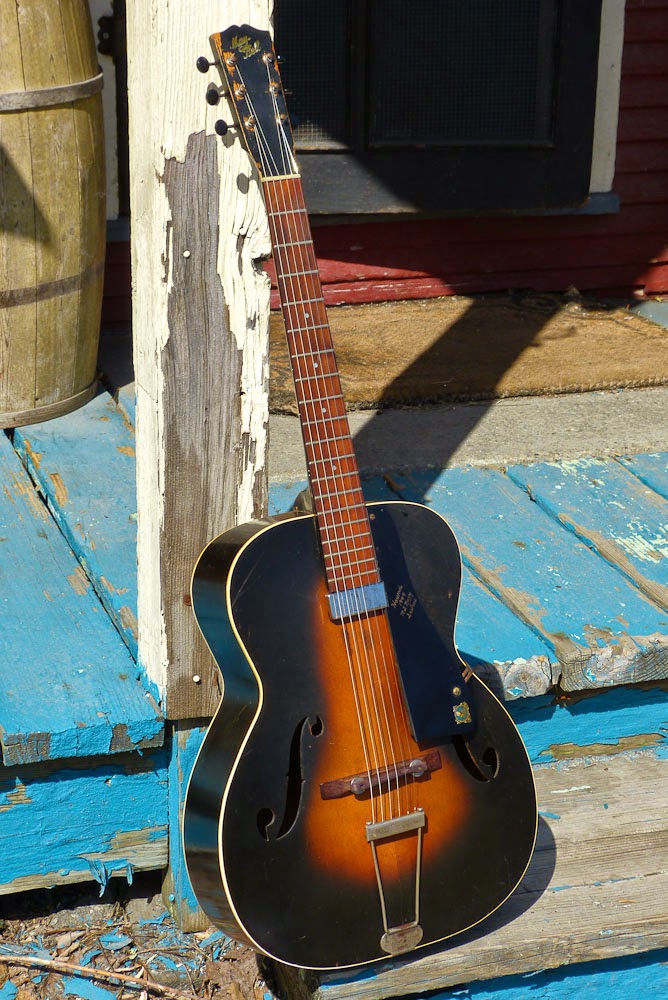1930s Slingerland MayBell Archtop WW2 Seabees Guitar
I actually worked on this guitar maybe... six? seven? years ago. I hadn't done much to it back then and it sold to a passerby in the shop on the cheap. Leap forward a bit and this came walking back in my door... this time as a consignment piece. It's very cool, for starters, and very distinctive, too. A friend of mine spotted this among the herd of "stuff getting ready for sale" and pulled it aside from himself. Now that his tax return is in... he'll be claiming it, soon, too!
I'm not at all sure who made the guitar but it's possible it was made by Regal or Oscar Schmidt for Slingerland as it has details that both makers used in their construction. It's all-solid wood and has birch back and sides and a spruce top. It has a very-playable, Gibson-ish, rounded C neck profile with a radiused rosewood fretboard and a "perfect" (for me, anyway) 25" scale length. The Gibson-style book headstock shape is icing on the cake.
I'm not at all sure who made the guitar but it's possible it was made by Regal or Oscar Schmidt for Slingerland as it has details that both makers used in their construction. It's all-solid wood and has birch back and sides and a spruce top. It has a very-playable, Gibson-ish, rounded C neck profile with a radiused rosewood fretboard and a "perfect" (for me, anyway) 25" scale length. The Gibson-style book headstock shape is icing on the cake.
This time around my work on the guitar included making a new rosewood bridge saddle/topper, a fret level/dress (and some fret reseating), glue-up of the top center seam, cleaning, and installation of a fretboard-installed floating jazz-style (Kent Armstrong slimbucker) humbucker pickup. The new owner didn't want any extra controls added to the top (to maximize acoustic sound) and so the pickup is installed "straight to the jack" with a deliciously low-profile tailpiece-mounted flush jack.
The acoustic sound is what you'd expect for a pressed-top archtop of this size (15" lower bout) -- compressed, biting, and great for chop chords or lead, but decidedly mid-range and simplistic. This is a good thing for recording or band use. Plugged in, though, and oh my -- it's deliciously thick. You can hear that in the soundclip above.
My replacement bone nut was still going strong and only needed minor adjustment after the fret work. I rehabbed the original tuners with some new buttons as they'd been replaced with some silly-looking closed-back Klusons at some point.
The board has a light (Martin-ish) radius and pearl dots. I added some side dots and, boy, it's a relief to have older medium-size fretwire on an old neck like this. It makes it feel modern and almost 50s.
I modified the pickup mount so it only "holds up" from the treble side. This keeps the look cleaner. The pickguard needed some modding, though, to fit it. A tiny pad of foam under the pickup allows for height adjustment on the bass side to adjust preferred tone.
The very cool World War II inscriptions on the guitar are seen here in "Hawaii, 1944, US Navy Seabees..."
Here's the Seabees insignia.
My new bridge topper is intonated for a wound G. This currently has a mixed set that's roughly comparable to an electric 11s set with a wound G. It sounds great with these roundwound strings and I'll bet it'd sing sickly-sweet 50s muffled jazz with a set of flats. I OK this guitar up to 12s.
Both bits of the tailpiece are clearly etched with "Billy R. James" -- who must've been the original owner.
Isn't that a slick looking piece of kit?
A bit of lube and the tuners work fine.
I added strap buttons as this will inevitably end up gigging.
Don't you love the fat C-shaped old mahogany (I think) neck?
Rather than use an endpin jack, I decided to make use of the bigger tailpiece hanger and mount a flush-style jack instead. This made it easy to ground-out the strings for the electric pickup via the tailpiece. No extra ground wire!





















Comments